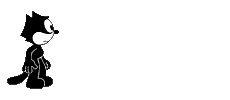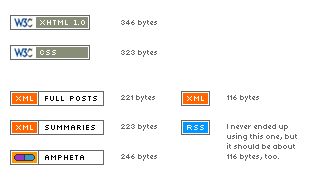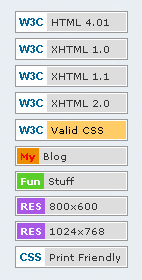

Looking back through these early collections of web graphics you recognize some images that made it into a lot of pages and became famous: rainbow dividers, the "New!" sign and Felix the Cat, a cult figure and perfect animation.


Some elements and sections of these free collections remind us of the historical peculiarities of the early web. For example "back" and "forward" buttons are part of the design set for non-professionals who ignored the corresponding buttons on the browser. Indeed, how could you delegate such an important navigational issue to the browser, an application that had a new version released every six months!
![]()
![]()
![]()
![]()

The same is true for so called "bullets", the small images used to replace the standard html list elements. It was a historical feature of the amateur web to prefer expression over structure. Early web makers were inspired by the possibility of using images and gladly substituted dull lists with spectacular graphics.
As we're reminded by the various "Best Viewed With..." buttons, the choice of browser was a big aesthetic and philosophic issue for web makers.

![]()
http://sillydog.org/netscape/now.html
Another important problem for Russian speaking Internet users, or more precisely writers using Cyrillic script, were the numerous character encodings. On the first page of a Russian site you had to choose the appropriate encoding system. These encoding buttons were "a land of opportunity" for designers and a lot played around with them making their own modifications.
In 1996, the soon-to-be #1 Russian Web Designer made 20 encoding button sets for different backgrounds and tastes. Within a few months they spread to countless .ru domains and became naturalized in the Russian web landscape.
![]()
![]()
![]()
![]()
![]()
![]()
![]()
![]()
![]()
![]()
![]()
![]()
![]()
![]()
![]()
![]()
![]()
![]()
![]()
![]()
![]()
![]()
![]()
![]()
![]()
![]()
![]()
![]()
![]()
![]()
![]()
![]()
![]()
![]()
![]()
![]()
![]()
![]()
![]()
![]()
![]()
![]()
![]()
![]()
![]()
![]()
![]()
![]()
![]()
![]()
![]()
![]()
![]()
![]()
![]()
![]()
![]()
![]()
![]()
![]()
![]()
![]()
![]()
![]()
![]()
![]()
![]()
![]()
![]()
![]()
![]()
![]()
![]()
![]()
![]()
![]()
![]()
![]()
![]()
![]()
![]()
![]()
![]()
![]()
![]()
![]()
![]()
![]()
![]()
![]()
They had a short life. By the end of 1998 the encoding choice became automatic. Buttons disappeared from the pages and even the legendary collection itself has vanished into history at archive.org/.../free/buttons/
The great MIDI collections remind us how the web sounded in the mid 90's but more about that in the MIDI chapter.
Free collections are the soul of the vernacular web. Lots of people were building their pages with free graphics and lots of people were making collections. The many-to-many principle really worked. Making your own site and building collections was a parallel process for a lot of people. The early web was more about spirit than skills. To distribute was no less important than to create.
It's only a slight exaggeration to state that, because of the modular nature of web page construction, even those sites that never contained a web graphics collection were, in themselves, collections. Every element on the page, every line, figure, button and sound was on its own and could easily be extracted, if not directly from the browser then from looking at the source code to find the URLS of the files.
As soon as users divided into designers and clients free collections lost their attractiveness for both sides. Around 1997 professional web sites were distancing themselves from the amateurs with the complete opposite of modular design. Graphic designs victorious expansion on the web had begun. (It was so fast that a lot of designers and researchers believe that web design is a junior member of graphic design). Designs were produced in Photoshop and later adapted for the browser. A page was created as a block then sliced into pieces. These pieces can't be considered as modules since each piece only exists in relation to its neighbour. Extracting or reusing the pieces is meaningless and undesirable to the authors.
A very typical example is from the Mobile Telecom site, made by Artemy Lebedev in 1997. It's a picture created and sliced in Photoshop.
Actually, it's one of the first corporate sites in Russia made by a professional. It became famous and the design was stolen many times. Lebedev has a museum dedicated to the clones of this piece. It's a very curious case, I think the people who stole the original design saw it more as a template: a guideline of how professional sites should now be created.
During the late 90's people were deleting links to the collections of files they had made or found. A lot of collections still exist because they weren't removed from the servers but they're difficult to find. So how can you find them if they're not linked? My favorite collection is no exception, there's no link to these pages so I better make one here.
On the other hand it would be very wrong to generalize and say that free collections are a thing of the past. If you search for "my collection of web graphics" you can still find a lot of special collections though not necessarily retro ones (btw "my" is a very important key word, leave it out and you'll be sent to commercial pages). They're upgraded and updated and there was even a moment of revival in 2001 when the section "God Bless America" was added to the private and public libraries of US users of all skill levels who wanted to demonstrate patriotic feelings on their home pages.

And a fresh market for free button makers is the "Verified XHTML" sign. The variety is still small but constantly growing and variations are needed to fit new design styles.


There are also examples at http://www.gifsamlung.de/, http://juanna.ch/, http://gifwelt.laureon.org/, http://gif.10000.ru/. They show that some have managed to bring their hobby to a higher level. Their libraries are huge and alive, life is in full swing in their forums and guest books. These are valuable sources for archivists and those who still prefer to build modular websites using available elements. Like a couple of London based media producers who compiled their wedding web site from apropriate graphics.
In 2004 British designer Bruce Lawson made a contribution to css zen garden (a collaborative effort to prove that CSS is a standart of web beauty). His GeoCities 1996 theme build of public domain gifs is a perfect reminder that real spirit will find its way around standards.
22.02.07:A big topic for collections today is new generation of counters.
They remind you and inform the visitors of your page about age of your child or supposed date of childs birth, number of days left till next marriage anniversary, christmas or what ever. On the Russian young mothers forum. you can see several counters as a signature to one posts or a comment.